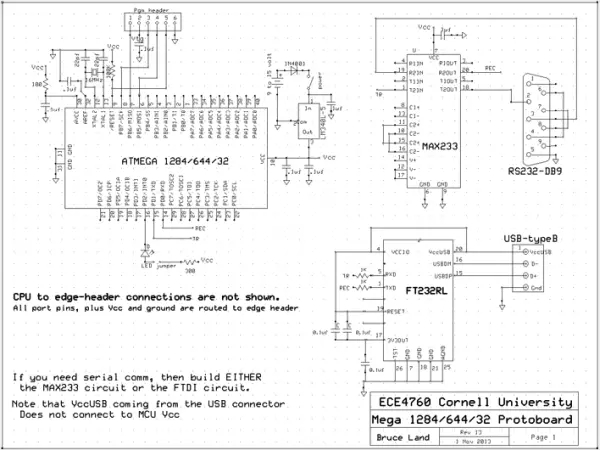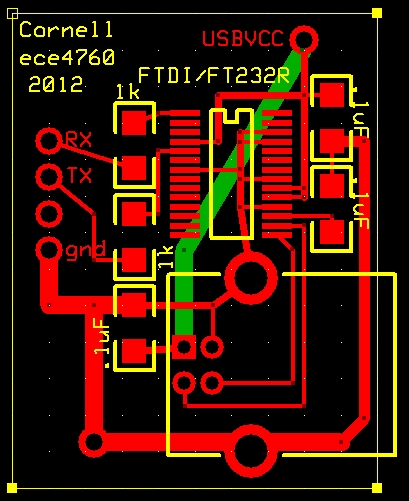Introduction
This document outlines a prototype board designed for use with the Atmel Mega644 or Mega32 (PDIP) MCU. The board incorporates essential components such as a power supply, crystal clock, and bypass capacitors. Additionally, it features a six-pin header for flash memory programming from devices like STK500 or AVRISPmkII. All port pins are accessible via a single row of vias spaced at 0.1-inch intervals. A 34-connection, SIP header plug facilitates attachment to other boards or solderless breadboards. Notably, all 32 port pins, along with Vcc and ground, are readily available. Furthermore, a separate interface is provided for serial communication.
Board Version 12 for 2012
The board layout for version 12 is detailed below. Please note that the design for the subsequent revision (v13-2013) includes main, USB, and serial boards. Express PCB design files are provided for modification or direct ordering from Express PCB.
Main Board
The main board, depicted above, incorporates a four-pin header matching either the serial or USB board. Notable changes from the previous model include the elimination of header pins for Aref and Vcc USB, along with solder pad removal for the TSSOP USB chip.
USB and Serial Boards
The USB and serial boards are designed for applications requiring serial communication. It’s essential to construct only one of these boards as per your specific needs. Instructions for building both boards are provided below.
Version 12 Construction Suggestions
Before commencing construction, it’s recommended to study the provided photos. Thinner components should be mounted first to avoid interference with soldering flat components. Follow these steps for efficient construction:
– Solder all capacitors and resistors onto the board.
– Add headers for TX, RX, LED, Vcc-Vtg, and programming.
– Incorporate the regulator, power switch, power plug, and diode.
– Test the power supply to ensure Vcc is within the specified range.
– Install the MCU socket and the 16 MHz (or 20 MHz) crystal.
– Optionally, add a reset button for additional functionality.
– Consider adding an LED and jumper for debugging purposes.
For detailed programming instructions and guidelines for flashing the microcontroller, refer to the provided documentation.
Useful Parts
A comprehensive list of useful parts, along with their corresponding Digikey part numbers, is provided for reference. These parts are essential for constructing and enhancing the functionality of the prototype board.
Conclusion
The prototype board for Atmel Mega644 offers a versatile platform for developing and testing MCU-based projects. With its integrated components and flexible design, it serves as a valuable tool for electronics enthusiasts and professionals alike. Through careful construction and adherence to provided guidelines, users can harness the full potential of this board for various applications.
Follow this link for complete project: Innovative Applications with the Atmel Mega644 Prototype Board




